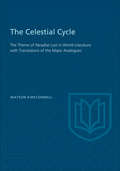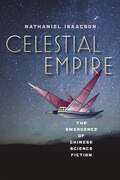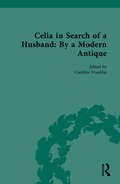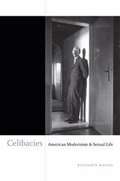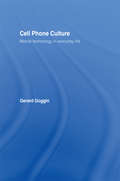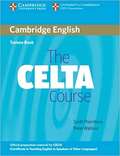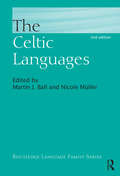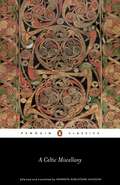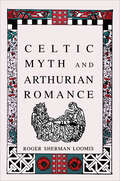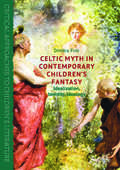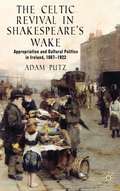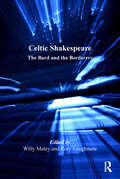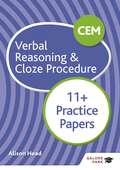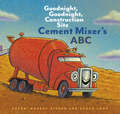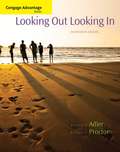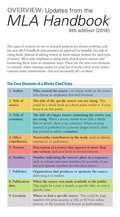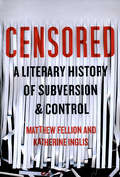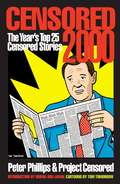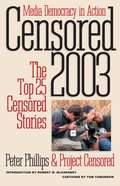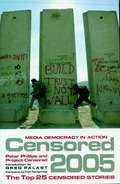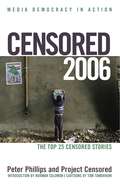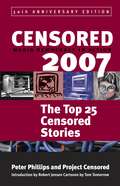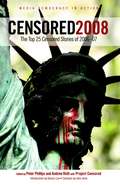- Table View
- List View
The Celestial Cycle: The Theme of Paradise Lost in World Literature with Translations of the Major Analogues
by Watson KirkconnellAn anthology of translated analogues, in whole or in part, on the theme of paradise lost. <P><P>The collection is divided into two parts. Part one is the analogues and part two is a descriptive catalogue of all the analogues the author consulted. <P>The book also includes a preface and lengthy introduction. It is an indispensable resource for any serious student or scholar of Milton's Paradise Lost.
Celestial Empire: The Emergence of Chinese Science Fiction (Early Classics Of Science Fiction Ser.)
by Nathaniel IsaacsonHow colonialism profoundly influenced the emergence of Chinese science fiction Challenging assumptions about science fiction's Western origins, Nathaniel Isaacson traces the development of the genre in China, from the late Qing Dynasty through the New Culture Movement. Through careful examination of a wide range of visual and print media—including historical accounts of the institutionalization of science, pictorial representations of technological innovations, and a number of novels and short stories—Isaacson makes a case for understanding Chinese science fiction as a product of colonial modernity. By situating the genre's emergence in the transnational traffic of ideas and material culture engendered by the presence of colonial powers in China's economic and political centers, Celestial Empires explores the relationship between science fiction and Orientalist discourse. In doing so it offers an innovative approach to the study of both vernacular writing in twentieth-century China and science fiction in a global context.
Celestina and the Ends of Desire
by E. Michael GerliOne of the most widely-read and translated Spanish works in sixteenth-century Europe was Fernando de Rojas' Celestina, a 1499 novel in dialogue about a couple that faces heartbreak and tragedy after being united by the titular brothel madam. In 'Celestina' and the Ends of Desire, E. Michael Gerli illustrates how this work straddles the medieval and the modern in its exploration of changing categories of human desire - from the European courtly love tradition to the interpretation of want as an insatiable, destructive force.Gerli's analysis draws on a wide range of Celestina scholarship but is unique in its use of modern literary and psychoanalytic theory to confront the problematic links between literature and life. Explorations of influence of desire on knowledge, action, and lived experience connect the work to seismic shifts in the culture of early modern Europe. Engaging and original, 'Celestina' and the Ends of Desire takes a fresh look at the timeless work's widespread appeal and enduring popularity.
Celia in Search of a Husband: By a Modern Antique (Chawton House Library: Women's Novels)
by Caroline FranklinThis ground-breaking nineteenth-century volume is of considerable scholarly interest as an example of a femino-centric popular novel. Celia in Search of a Husband is a high-spirited and entertaining example of an anti-Jacobin novel, written at the height of the backlash against female intellectuals during the Napoleonic wars. Despite this hostile climate, the author sought to acknowledge the importance of female education and independence whilst at the same time endorsing the traditional Christian teaching that a wife should be subordinate to her husband. Although second wave feminists prioritized the progressive writers with whom they more readily identified, more recent scholarship has rightly paid close attention to conservative or moralist writers such as Miss Byron and recognized how influential they were. Accompanied by extensive editorial commentary, this edition of Celia in Search of a Husband contributes to this scholarship on the literary history of women’s writing, and will be a welcome to those with a particularly interest in women’s writing, satiric novels and spoofs, and Jane Austen.
Celibacies: American Modernism and Sexual Life
by Benjamin KahanIn this innovative study, Benjamin Kahan traces the elusive history of modern celibacy. Arguing that celibacy is a distinct sexuality with its own practices and pleasures, Kahan shows it to be much more than the renunciation of sex or a cover for homosexuality. Celibacies focuses on a diverse group of authors, social activists, and artists, spanning from the suffragettes to Henry James, and from the Harlem Renaissance's Father Divine to Andy Warhol. This array of figures reveals the many varieties of celibacy that have until now escaped scholars of literary modernism and sexuality. Ultimately, this book wrests the discussion of celibacy and sexual restraint away from social and religious conservatism, resituating celibacy within a history of political protest and artistic experimentation. Celibacies offers an entirely new perspective on this little-understood sexual identity and initiates a profound reconsideration of the nature and constitution of sexuality.
Cell Phone Culture: Mobile Technology in Everyday Life
by Gerard GogginProviding the first comprehensive, accessible, and international introduction to cell phone culture and theory, this book is and clear and sophisticated overview of mobile telecommunications, putting the technology in historical and technical context. Interdisciplinary in its conceptual framework, Cell Phone Culture draws on a wide range of national, regional, and international examples, to carefully explore the new forms of consumption and use of communication and media technology that the phenomenon of mobiles represents. This fascinating biography of an important cultural object: adopts an integrated multiperspective approach considers the mobile phone and its history, production, design, consumption and representation examines the implications in contemporary media convergence such as digital photography an mobile internet. Also reflecting on the challenges and provocations of mobile phone technology and use, this is an absolute must read for any student of media studies, cultural studies or technology.
Cell Phones: Bringing the World Together [Grade 2]
by Chandler Tyrrell Lyle MillerNIMAC-sourced textbook
The CELTA Course Trainee Book
by Scott ThornburyThe CELTA Course is the only CELTA preparation course endorsed by Cambridge ESOL. It provides full coverage of the CELTA syllabus in a ready-to-use course. The CELTA Course is divided into user-friendly sections: * Input sessions (40 units on 'The learners and their contexts', 'Classroom teaching', 'Language awareness', and 'Professional development') * Teaching practice * Classroom observation * Written assignments and tutorials * 'Resource file' The Trainee Book includes a range of material to be used in input sessions, helpful advice about the course, and a wealth of useful reference material. The Trainer's Manual includes suggestions on how to best use the material with trainees, as well as help and advice on how to prepare trainees for teaching practice, lesson observations, written assessment and tutorials.
The Celtic Languages: Readings In The Brythonic Languages, Festschrift For T. Arwyn Watkins (Routledge Language Family Series #68)
by Martin J. Ball Nicole MüllerThe Celtic Languages describes in depth all the Celtic languages from historical, structural and sociolinguistic perspectives with individual chapters on Irish, Scottish Gaelic, Manx, Welsh, Breton and Cornish. This second edition has been thoroughly revised to provide a comprehensive and up-to-date account of the modern Celtic languages and their current sociolinguistic status along with complete descriptions of the historical languages. This comprehensive volume is arranged in four parts. The first part offers a description of the typological aspects of the Celtic languages followed by a scene setting historical account of the emergence of these languages. Chapters devoted to Continental Celtic, Old and Middle Irish, and Old and Middle Welsh follow. Parts two and three are devoted to linguistic descriptions of the contemporary languages. Part two has chapters on Irish, Scots Gaelic and Manx, while Part three covers Welsh, Breton and Cornish. Part four is devoted to the sociolinguistic situation of the four contemporary Celtic languages and a final chapter describes the status of the two revived languages Cornish and Manx. With contributions from a variety of scholars of the highest reputation, The Celtic Languages continues to be an invaluable tool for both students and teachers of linguistics, especially those with an interest in typology, language universals and the unique sociolinguistic position which the Celtic languages occupy. Dr Martin J. Ball is Hawthorne-BoRSF Endowed Professor, and Director of the Hawthorne Research Center, at the University of Louisiana at Lafayette. Dr Ball has over 120 academic publications. Among his books are The Use of Welsh, Mutation in Welsh, and Welsh Phonetics. Dr Nicole Müller is Hawthorne-BoRSF Endowed Professor at the University of Louisiana at Lafayette. Among her books are Mutation in Welsh, and Agents in Early Irish and Early Welsh.
A Celtic Miscellany: Selected and Translated by Kenneth Hurlstone Jackson
by Kenneth Hurlstone JacksonIncluding works from Welsh, Irish and Scottish Gaelic, Cornish, Breton and Manx, this Celtic Miscellany offers a rich blend of poetry and prose from the eighth to the nineteenth century, and provides a unique insight into the minds and literature of the Celtic people. It is a literature dominated by a deep sense of wonder, wild inventiveness and a profound sense of the uncanny, in which the natural world and the power of the individual spirit are celebrated with astonishing imaginative force. Skifully arranged by theme, from the hero-tales of Cú Chulainn, Bardic poetry and elegies, to the sensitive and intimate writings of early Celtic Christianity, this anthology provides a fascinating insight into a deeply creative literary tradition.
Celtic Myth and Arthurian Romance
by Roger Sherman LoomisKing Arthur was not an Englishman, but a Celtic warrior, according to Loomis, whose research into the background of the Arthurian legend reveals findings which are both illuminating and highly controversial. The author sees the vegetarian goddess as the prototype of many damsels in Arthurian romance, and Arthur's knights as the gods of sun and storm. If Loomis's arguments are accepted, where does this leave the historic Arthur?
Celtic Myth in Contemporary Children’s Fantasy: Idealization, Identity, Ideology (Critical Approaches to Children's Literature)
by Dimitra FimiThis book examines the creative uses of "Celtic" myth in contemporary fantasy written for children or young adults from the 1960s to the 2000s. Its scope ranges from classic children's fantasies such as Lloyd Alexander's The Chronicles of Prydain and Alan Garner's The Owl Service, to some of the most recent, award-winning fantasy authors of the last decade, such as Kate Thompson (The New Policeman) and Catherine Fisher (Darkhenge). The book focuses on the ways these fantasy works have appropriated and adapted Irish and Welsh medieval literature in order to highlight different perceptions of "Celticity. " The term "Celtic" itself is interrogated in light of recent debates in Celtic studies, in order to explore a fictional representation of a national past that is often romanticized and political.
The Celtic Revival in Shakespeare’s Wake
by Adam PutzThis book reconsiders the Celtic Revival by examining appropriations of Shakespeare, using close readings of works by Arnold, Dowden, Yeats and Joyce to reveal the pernicious manner in which the discourse of Anglo-Irish cultural politics informed the critical paradigms that mediated the reading of Shakespeare in Ireland for a generation.
Celtic Shakespeare: The Bard and the Borderers
by Rory LoughnaneDrawing together some of the leading academics in the field of Shakespeare studies, this volume examines the commonalities and differences in addressing a notionally 'Celtic' Shakespeare. Celtic contexts have been established for many of Shakespeare's plays, and there has been interest too in the ways in which Irish, Scottish and Welsh critics, editors and translators have reimagined Shakespeare, claiming, connecting with and correcting him. This collection fills a major gap in literary criticism by bringing together the best scholarship on the individual nations of Ireland, Scotland and Wales in a way that emphasizes cultural crossovers and crucibles of conflict. The volume is divided into three chronologically ordered sections: Tudor Reflections, Stuart Revisions and Celtic Afterlives. This division of essays directs attention to Shakespeare's transformed treatment of national identity in plays written respectively in the reigns of Elizabeth and James, but also takes account of later regional receptions and the cultural impact of the playwright's dramatic works. The first two sections contain fresh readings of a number of the individual plays, and pay particular attention to the ways in which Shakespeare attends to contemporary understandings of national identity in the light of recent history. Juxtaposing this material with subsequent critical receptions of Shakespeare's works, from Milton to Shaw, this volume addresses a significant critical lacuna in Shakespearean criticism. Rather than reading these plays from a solitary national perspective, the essays in this volume cohere in a wide-ranging treatment of Shakespeare's direct and oblique references to the archipelago, and the problematic issue of national identity.
CEM 11+ Verbal Reasoning & Cloze Procedure Practice Papers
by Alison HeadPractice exam papers to test pupils ahead of the CEM 11+ Verbal Reasoning test, including those taking bespoke tests created by CEM for individual schools. Four levelled papers test pupils' skills in verbal reasoning and cloze procedure.The papers are designed to:- Develop and perfect exam technique for all CEM 11+ tests- Teach pupils to improve their response rates with timed papers- Provide a variety of question formats to suit paper-based and online tests- Identify weaker areas and improve results by studying the answers, which contain references to Galore Park's revision materials for guidance and useful tips- The resource also contains links to downloadable answer sheets so that the tests can be re-sat.These practice papers are part of Galore Park's 11+ revision series, which provides a three-step learning journey that teaches children the skills needed to pass rigorous school entrance exams.
Cement Mixer's ABC: Goodnight, Goodnight, Construction Site (Goodnight, Goodnight, Construc)
by Sherri Duskey RinkerWritten by the author of the New York Times bestselling Goodnight, Goodnight Construction Site children's book series.More than two million Goodnight, Goodnight Construction Site books have sold across the series. From the author of the best-selling, #1 New York Times Best-selling book Goodnight, Goodnight Construction Site, this new alphabet concept board book features the same characters as the original, but is written for a younger audience. This lyrical story helps toddlers sing along with Cement Mixer, who churns out a rollicking alphabet rhyme while he shows Bulldozer that work can be fun and teaches little readers the words of the construction site, from A to Z. Work is always lighter when there is someone by your side to sing along!Teaches children about friendship, teamwork, and the alphabet.Features characters from the original book.• Teaches toddlers their ABCs• Kids learn about teamwork• Story highlights the value of friendshipFans of Mighty, Mighty Construction Site, Dump Truck's Colors, and Goodnight, Goodnight, Construction Site and Steam Train, Dream Train Board Books Boxed Set will love this book by author Sherri Duskey Rinker and illustrator Ethan Long. • Perfect book for parents, grandparents, caregivers, teachers, and librarians to read to kids• Makes a great baby shower gift or birthday present for small children. • A great addition to the Goodnight, Goodnight Construction Site book series
Cengage Advantage Books: Looking Out, Looking In (Fourteenth Edition)
by Ronald B. Adler Russell F. Proctor IIUsed by more than a million students, LOOKING OUT/LOOKING IN, Fourteenth Edition, maintains its outstanding tradition of combining current information with a fun, reader-friendly voice that links course topics to your everyday life. You'll discover how you will benefit from improving your interpersonal skills and sharpening your critical understanding of the communication process. Diverse and compelling examples illustrate and reinforce how communication skills can affect both the world around you and your own lives. Improve your relationships and your future career success with this engaging text that teaches interpersonal concepts through popular music, art, movies, and television.
The Cengage Essential Reference Card to the MLA Handbook for Writers of Research Papers
by Karen Mauk Cengage Learning StaffThis card outlines the essential changes to the Modern Language Association's documentation style as described in the recently published 2016 MLA HANDBOOK, Eighth Edition.
Censored: A Literary History of Subversion and Control
by Matthew Fellion Katherine InglisWhen Henry Vizetelly was imprisoned in 1889 for publishing the novels of Émile Zola in English, the problem was not just Zola’s French candour about sex – it was that Vizetelly’s books were cheap, and ordinary people could read them. Censored exposes the role that power plays in censorship. In twenty-five chapters focusing on a wide range of texts, including the Bible, slave narratives, modernist classics, comic books, and Chicana/o literature, Matthew Fellion and Katherine Inglis chart the forces that have driven censorship in the United Kingdom and the United States for over six hundred years, from fears of civil unrest and corruptible youth to the oppression of various groups – religious and political dissidents, same-sex lovers, the working class, immigrants, women, racialized people, and those who have been incarcerated or enslaved. The authors also consider the weight of speech, and when restraints might be justified. Rich with illustrations that bring to life the personalities and the books that feature in its stories, Censored takes readers behind the scenes into the courtroom battles, legislative debates, public campaigns, and private exchanges that have shaped the course of literature. A vital reminder that the freedom of speech has always been fragile and never enjoyed equally by all, Censored offers lessons from the past to guard against threats to literature in a new political era.
Censored 2000: The Year's Top 25 Censored Stories
by Peter Phillips Project Censored Mumia Abu-Jamal Tom TomorrowThe yearly volumes of Censored, in continuous publication since 1976 and since 1995 available through Seven Stories Press, is dedicated to the stories that ought to be top features on the nightly news, but that are missing because of media bias and self-censorship. The top stories are listed democratically in order of importance according to students, faculty, and a national panel of judges. Each of the top stories is presented at length, alongside updates from the investigative reporters who broke the stories.Beyond the Top 25 stories, additional chapters delve further into timely media topics: The Censored News and Media Analysis section provides annual updates on Junk Food News and News Abuse, Censored Déjà Vu, signs of hope in the alternative and news media, and the state of media bias and alternative coverage around the world. In the Truth Emergency section, scholars and journalists take a critical look at the US/NATO military-industrial-media empire. And in the Project Censored International section, the meaning of media democracy worldwide is explored in close association with Project Censored affiliates in universities and at media organizations all over the world.A perennial favorite of booksellers, teachers, and readers everywhere, Censored is one of the strongest life signs of our current collective desire to get the news we citizens need--despite what Big Media tells us.
Censored 2003: The Top 25 Censored Stories
by Robert W. Mcchesney Peter Phillips Project Censored Tom TomorrowThe yearly volumes of Censored, in continuous publication since 1976 and since 1995 available through Seven Stories Press, is dedicated to the stories that ought to be top features on the nightly news, but that are missing because of media bias and self-censorship. The top stories are listed democratically in order of importance according to students, faculty, and a national panel of judges. Each of the top stories is presented at length, alongside updates from the investigative reporters who broke the stories.
Censored 2005: The Top 25 Censored Stories
by Greg Palast Peter Phillips Project Censored Tom TomorrowThe yearly volumes of Censored, in continuous publication since 1976 and since 1995 available through Seven Stories Press, is dedicated to the stories that ought to be top features on the nightly news, but that are missing because of media bias and self-censorship. The top stories are listed democratically in order of importance according to students, faculty, and a national panel of judges. Each of the top stories is presented at length, alongside updates from the investigative reporters who broke the stories.
Censored 2006: The Top 25 Censored Stories
by Norman Solomon Peter Phillips Project Censored Tom TomorrowThe yearly volumes of Censored, in continuous publication since 1976 and since 1995 available through Seven Stories Press, is dedicated to the stories that ought to be top features on the nightly news, but that are missing because of media bias and self-censorship. The top stories are listed democratically in order of importance according to students, faculty, and a national panel of judges. Each of the top stories is presented at length, alongside updates from the investigative reporters who broke the stories.
Censored 2007: The Top 25 Censored Stories
by Peter Phillips Project Censored Tom Tomorrow Robert JensenThe yearly volumes of Censored, in continuous publication since 1976 and since 1995 available through Seven Stories Press, is dedicated to the stories that ought to be top features on the nightly news, but that are missing because of media bias and self-censorship. The top stories are listed democratically in order of importance according to students, faculty, and a national panel of judges. Each of the top stories is presented at length, alongside updates from the investigative reporters who broke the stories.
Censored 2008: The Top 25 Censored Stories of 2006-07
by Dennis Loo Peter Phillips Project Censored John Jonik Andrew RothThe yearly volumes of Censored, in continuous publication since 1976 and since 1995 available through Seven Stories Press, is dedicated to the stories that ought to be top features on the nightly news, but that are missing because of media bias and self-censorship. The top stories are listed democratically in order of importance according to students, faculty, and a national panel of judges. Each of the top stories is presented at length, alongside updates from the investigative reporters who broke the stories.
